'Raja' means 'King' and 'Sthan' means place. Put together, Rajasthan is the 'Land of The Kings'. It was previously called Rajputana. Over the years it has been ruled by various kings including the Rajput, Marathas and even Muslim rulers, which have resulted in Rajasthan, bearing numerous beautiful forts with a wide variety in its architecture and diverse language and culture of its people. Rajasthan, in spite of being a desert, has been endowed with such beautiful sites that include various palaces, forts and pilgrim centres that define what Rajasthan is.
Rajasthan is famous for its prestigious past and its various customs and traditions. It truly gives an insight into historical India and its remarkable diversity.
Read about the Culture of Rajasthan that makes it one of the most tourist-oriented states in India
As a tourist, there are some foods that you need to try. Rajasthani food is known for its various spices and also its sweetness. Rajasthan is most famous for dalbati - A dish comprising of dal and wheat flour kneaded with yoghurt and dressed in ghee. It is also famous for kachori - the kachori in Rajasthan are of two types - sweet and spicy. The spicy kachori is called the pyaaz or onion kachori, and the sweet kachori called the mawa kachori. Both these kachoris are easily available in any food stalls in Rajasthan. Ghewar and gheriya are some delectable sweet dishes originating from Mewar, available in most restaurants at Rajasthan. Most of the Rajasthani dishes are made in ghee. More than 70% of people in Rajasthan are Lacto vegetarian making it one of the most vegetarian states in India.
. 
|
|
The women wear sarees with the 'odhni' covering their head as a sign of respect. The men wear dhotis and kurtas with a headgear called paggri or safah.
The designs on their clothing are either embroidered or dotted. The material of the clothing is usually cotton and even silk for women.
The traditional costume of the women of Rajasthan is mostly a long skirt with a narrow waist that looks like an umbrella at the base. These skirts along with the top are called as Ghaghara which comes in vibrant colors. Usually the length of the skirt stops much before the ankle so that the accessory worn in the leg is visible. These skirts and dupattas are dyed or printed with mothras and lehariya print. Jaipur the capitalstate is very famous across the globe for its jewelry.
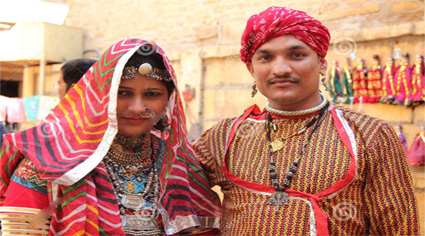
|
|
Many traditional instruments are used by them that include sarangi, kamayach, dhols, shenhai, and been. Folk songs were usually for certain purposes like weddings or birth or were passed to tell a story of bravery or a romantic tale. They were usually in the form of ballads.
The dance is varied as well. Dance differed among different tribes. It was mainly for the entertainment of the people and the king. Some of the dances include chang, ghoomer, bhopa, tejali, and kathipuli. Ghoomer dance, which originated in Udaipur, has gained international recognition and appreciation.
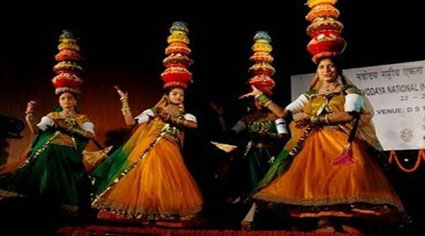
|
|
Camels are commonly found animals in Rajasthan. Camels are desert animals that are meant to survive conditions of scarcity of water, extreme winds, heat and cold due to their biology. Most camps in Rajasthan will include camel rides, and you will get to experience how well the camels can travel in deserts due to their long footed legs. Camel fairs take place every year in Bikaner, Pushkar and other regions. It is a festival or celebration of sorts dedicated to the ship of the desert and their owners. There are various events and competitions carried out for fun like camel race and camel dance. These festivals are usually held for two days.
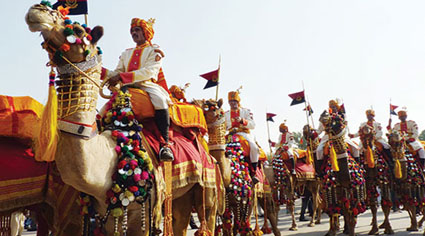
|
|
The customs and traditions followed by the people of Rajasthan are those that pertain to that of the Vedic rites and rituals. The people of Rajasthan very strictly adhere to these traditional customs which is very essential according to every man and woman of Rajasthan. Each and every custom and rituals from birth to death according to the Vedas is followed by the people with just slight variations based on their region and the numerous sub castes. These ceremonies which have to be done as a part of their customs are known as Samskaras which depict the three stages of life namely birth, marriage and death. There are nearly sixteen Samskaras. At the time of a girl's pregnancy charms are tied around the neck and waist and also to prevent the evil eye falling on her, a knife is put under her pillow every night and is not allowed to go under certain specific tree where the Rajasthani's believe that spirits reside on those trees. The girl who is pregnant for the first time has to come to her parents well in advance.
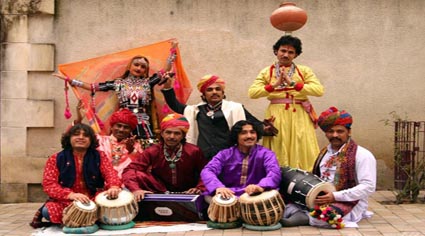
|
|
f you visit Rajasthan, be sure to reserve a few hours or even a day for shopping. You will find beautiful carpets, garments, jewellery and more, that are all made by the local people. Any leather item is usually camel leather - they use it making journals, shoes and bags. The carpets are made from the hand-knitting techniques and much like Persian carpets; they have a geometric design and borders. There are also many miniature items made out of red sand or clay as toys for kids or decoration pieces with bells attached to it. You may also find safah or paggri (traditional headwear) in most of the shops that you may bring back as a memory from the place.
Shopping in Rajasthan is very reasonable and is an opportunity not to be missed. Antiques are a whole different thing. If you like to collect antiques, there are various sellers in Rajasthan. However, do some research on which sellers are authorised so that you are aware where you can purchase them. Most antiques are things that were the possessions of the kings.
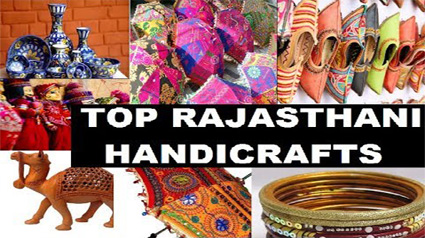
|
|







